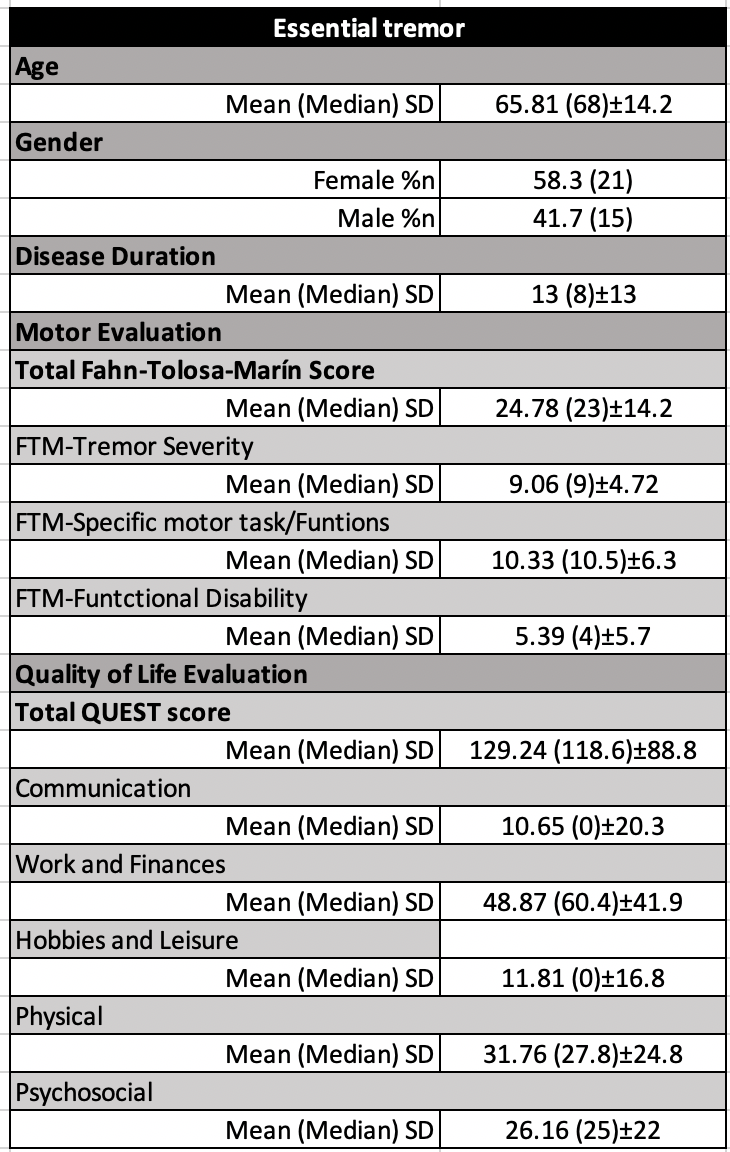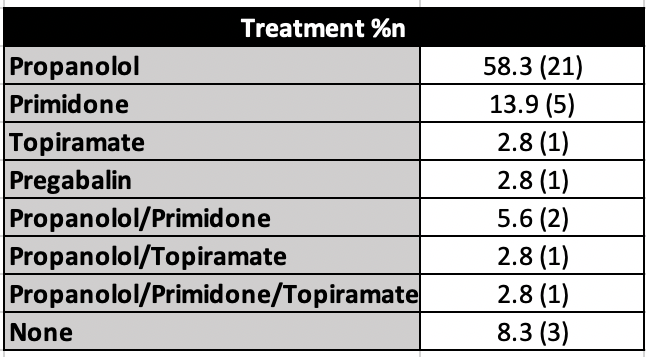Objective: Identify among patients attending the Movement Disorders Unit at the National Institute of Neurology and Neurosurgery, Mexico, how much quality of life is reduced due to the severity of the disease.
Background: Essential tremor (ET) is considered to be a tremor syndrome characterized by isolated bilateral upper-limb action tremor with a duration of at least 3 years, with or without tremor in other locations, such as head, larynx (voice tremor), or lower limbs [1]. Disability and impairment, related to motor and nonmotor symptoms of the disease, can be specifically captured by the Quality of Life in Essential Tremor Questionnaire (QUEST)[2]. Recent studies confirmed the impact of NMSs on patients’ quality of life (QoL) [3].
Method: A cross-sectional, observational study. We included patients with the diagnosis of ET. Fahn-Tolosa-Marin scale was used for the motor evaluation of the patients with ET (PwET). For QoL evaluation, the Quality of Life in Essential Tremor Questionnaire (QUEST) was used. Spearman’s correlation test was used to assess the correlation between FTM and QUEST.
Results: We included a total of 36 patients (58.3% female), with a mean age of 65.81±14.2. The mean duration of the disease was 13 years with a median of 8 years. The mean score of the FTM was 24.78±14.2, and the mean score for the QUEST was 129.24±88.8. We found a significant correlation between FTM-Functional Disability and the QUEST Physical subscore (ρ=0.52, p<0.01), and Total QUEST score (ρ=0.35, p<0.05). A moderate correlation was found between the Total FTM score and the QUEST Physical subscore (ρ=0.38, p<0.05). No significant correlation was found between the FTM total score and the Total QUEST score.
Conclusion: The present study found a significant correlation between FTM-Functional Disability and the QUEST Physical subscore (ρ=0.52, p<0.01), and Total QUEST score (ρ=0.35, p<0.05). However, no significant correlation was found between the FTM total score and the Total QUEST score. Thus, a larger sample size is needed for future studies.
References: 1. Haubenberger, D., Hallett, M. Essential Tremor. New England Journal of Medicine, 2018; 378(19): 1802–1810. doi:10.1056/nejmcp1707928. 2. Tröster, A., Pahwa, R., Fields, J., Tanner, C. and Lyons, K. Quality of life in Essential Tremor Questionnaire (QUEST): Development and initial validation. Parkinsonism & Related Disorders, 2005; 11(6): 367-373. doi:10.1016/j.parkreldis.2005.05.009. 2. Shalash, AS., Mohamed H., Mansour AH., et al. Clinical Profile of Non-Motor Symptoms in Patients with Essential Tremor: Impact on Quality of Life and Age-Related Differences. Tremor Other Hyperkinet Mov. 2019; 9. doi: 10.7916/tohm.v0.736.
To cite this abstract in AMA style:
S. Lopez-Alamillo, O. Esquivel-Zapata, C. Sarabia-Tapia, A. Cervantes-Arriaga, R. Abundes-Corona, F. Herrera-Rodriguez, E. Escobar, O. Cárdenas, Y. Ríos, I. González, M. Rodriguez-Violante. Quality of Life in Mexican Patients with Essential Tremor [abstract]. Mov Disord. 2020; 35 (suppl 1). https://www.mdsabstracts.org/abstract/quality-of-life-in-mexican-patients-with-essential-tremor/. Accessed December 12, 2025.« Back to MDS Virtual Congress 2020
MDS Abstracts - https://www.mdsabstracts.org/abstract/quality-of-life-in-mexican-patients-with-essential-tremor/


